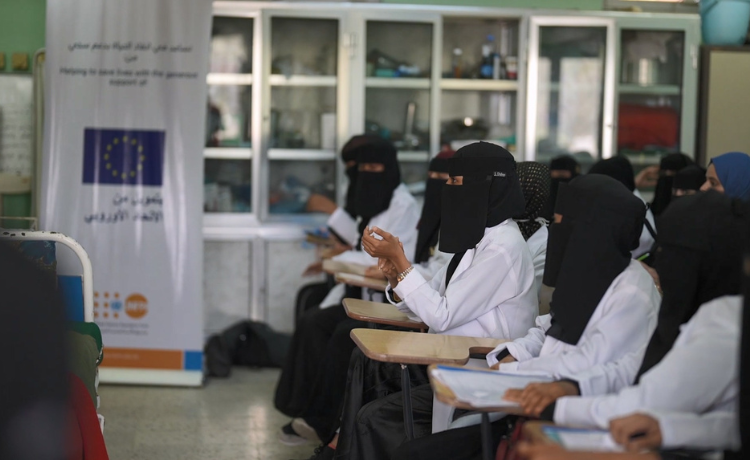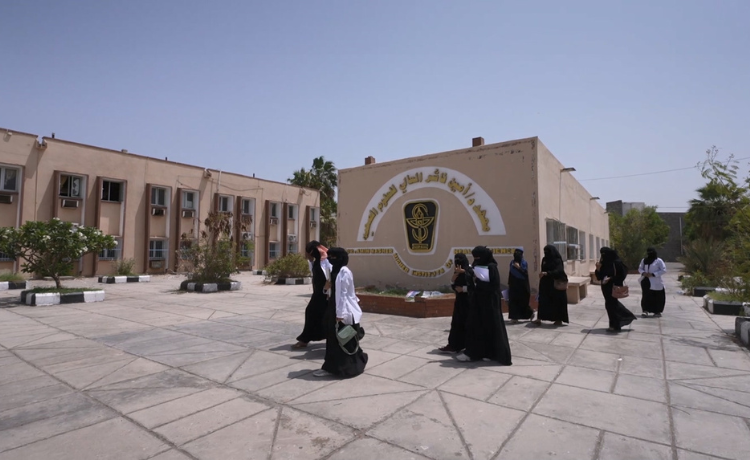News
Investing in skilled midwives to save lives and brighten futures in Yemen
- 10 February 2025
News
AL HUDAYDAH/SANA’A GOVERNORATES, Yemen – Rokia Dukhna, 22, had been determined to become a midwife since her own mother endured a tragic experience during childbirth.
Ms. Dukhna grew up in the village of Al-Qahira, in Yemen’s coastal Al Hudaydah Governorate – a rural area where essential health services are scarce and often inaccessible. Many women face complications in pregnancy and labour, with few skilled midwives to help them – including her mother, who tragically suffered a stillbirth.
“The lack of skilled midwives and the absence of proper training caused a devastating mistake,” Ms. Duhna explained to UNFPA, the United Nations sexual and reproductive health agency. “But it pushed me to pursue midwifery, so I could ensure that no other mother or baby would suffer the same fate.”
Despite improvements in recent years, Yemen still has one of the highest maternal mortality rates in the region, at 183 maternal deaths per 100,000 live births. The national healthcare system has been stretched to breaking point after years of conflict, repeated climate disasters and a volatile economic situation. Some forty per cent of health facilities are partially functioning or completely out of service because of shortages in staff, funds, electricity, medicine and equipment, leaving millions without adequate care.
Training future life savers

Research shows that midwives could avert around two thirds of all maternal and newborn deaths and stillbirths globally, and deliver some 90 per cent of all essential sexual, reproductive, maternal and newborn health services. Yet the profession has for too long been marginalized within health systems, an imbalance UNFPA is working to rectify by investing in midwifery training and deployment to reach more women and save more lives, quickly and at scale.
In 2020, with funding from the European Union, UNFPA established a series of three-year training programmes at seven institutes in remote and hard-to-access areas, where rates of maternal and newborn deaths in Yemen are the highest. Although Ms. Dukhna had to travel long distances to reach one, she persevered.
“It was exhausting, but we worked hard and [...] after three years, we graduated,” she said. “We managed to bring joy to the hearts of mothers and fathers.”
“Fear was always with me, especially when I had to deal with complicated births. But I knew that my dream wasn’t just my own [...] I wanted to be a role model for future generations.”
Ms. Dukhna has ambitions to help even more women in her community. “I hope to open a small clinic in my village to support and care for mothers and newborns. [...] I want every rural area to have qualified medical professionals who can save the lives of mothers and children.”
Investing in women is investing in society

Naseem, 28, is another recent graduate of the initiative. She grew up in the village of Al-Haddab, in the Sana’a Governorate, where her mother encouraged her to work hard and study medicine. “Thanks to her, I was able to finish high school, which was the first step toward fulfilling my long-held dream: To become a doctor.”
But life threw many challenges in Naseem’s path, especially when her husband lost his job after Yemen's economy collapsed. “I was the sole provider for our family. I worked as a teacher to support us, but my dream of becoming a doctor never left my heart.”
It was a commitment that would prove well founded when she heard of the UNFPA programme. “I received a call about a training opportunity to become a rural midwife. Despite the obstacles – including family disagreements as I became busier – I was determined. This training wasn’t just a chance for me to work; it was my way of proving myself, saving lives in my village, and improving my children’s futures.”
The path to progress
By the end of 2024, 139 midwives had graduated from the UNFPA-supported institutes and were sent to areas most in need – an initiative that is not only saving lives, but empowering women and contributing to healthier communities.
“I will never forget when I witnessed a difficult birth that ended with the mother being paralyzed due to the lack of a qualified midwife. That scene shook me to my core,” recalled Naseem.
“I realized the immense need to have at least one trained medical professional in every remote village. It was that moment that fuelled my desire to become a midwife, to ensure no other woman would suffer due to the lack of proper care.”
Over 440,000 women benefitted from the programmes last year, of whom more than 50,000 had safe home deliveries with community midwives, and more than 77,000 received family planning services. A further 9,300 women with pregnancy complications were referred to health facilities, ensuring timely and specialized care.